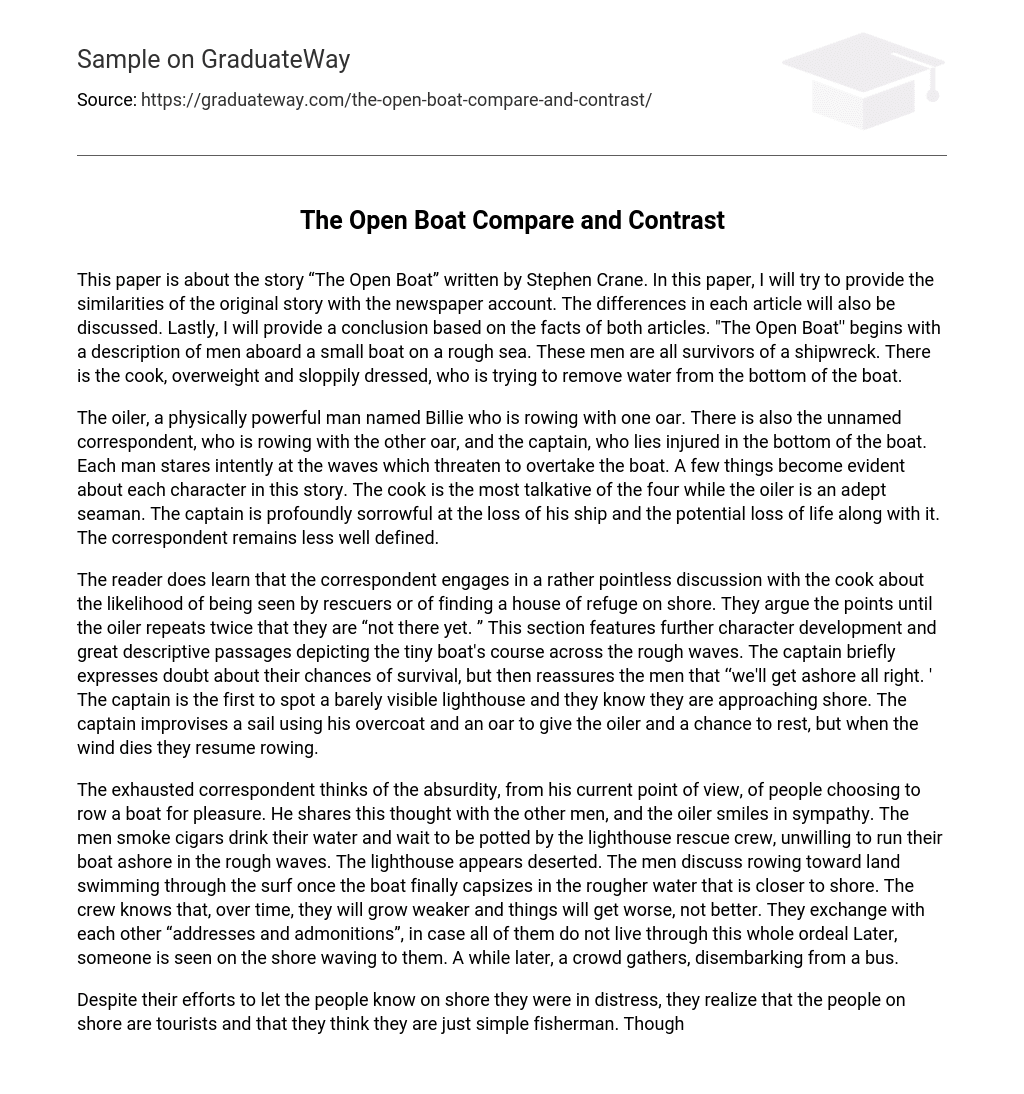This paper examines the story “The Open Boat” by Stephen Crane, comparing it to a newspaper account. Similarities and differences between the two articles will be explored, culminating in a conclusion based on the factual evidence. “The Open Boat” narrates the experiences of men on a small boat amidst turbulent waters, all of whom have survived a shipwreck. Among them is an overweight and unkempt cook who struggles to bail out water from the boat.
The narrator describes the men in the boat: Billie, a strong oiler rowing with one oar, the unnamed correspondent rowing with the other oar, and the injured captain lying at the bottom of the boat. Each man is focused on the waves that threaten to engulf them. The cook is talkative, the oiler skilled at sailing, and the captain deeply saddened by the loss of his ship and potential loss of life. The correspondent’s character remains unclear.
The passage reveals that the correspondent engages in a seemingly pointless discussion with the cook regarding the likelihood of being spotted by rescuers or finding a refuge on the shore. They debate these points until the oiler emphasizes twice that they have not reached their destination yet. This segment contributes to character development and includes vivid descriptions of the small boat’s journey through turbulent waves. The captain briefly expresses doubts about their survival prospects but subsequently reassures the crew that they will safely reach the shore. It is the captain who first spots a barely discernible lighthouse, indicating their proximity to land. As a makeshift solution, the captain uses his overcoat and an oar to create a sail, enabling the oiler to rest. However, they resume rowing when the wind subsides.
The tired journalist contemplates the ridiculousness of people willingly choosing to row a boat for fun. He shares this sentiment with his companions, and the oiler sympathetically smiles. The men smoke cigars, drink water, and wait for the lighthouse rescue team to spot them, avoiding the risky decision to bring the boat ashore in rough waves. The lighthouse seems abandoned. The men discuss the idea of rowing towards land and swimming through the surf after their boat eventually capsizes in the rougher waters near the shore. They understand that their strength will diminish over time and their situation will deteriorate. They exchange contact information and advice cautiously, in case not all of them make it through the entire ordeal. Eventually, they spot someone on the shore waving at them. After a while, a crowd emerges from a bus, gathering at the scene.
Despite their attempts to signal their distress to the people on shore, they come to an understanding that the individuals on land are tourists who mistakenly perceive them as ordinary fishermen. Each man on the boat is plagued with thoughts of drowning. At daybreak, the men collectively determine that their sole survival opportunity lies in rowing towards the distant shore once again and subsequently swimming after the boat ultimately overturns. Acting upon the Captain’s command, the oiler directs the boat straight towards the shore, resulting in its capsizing. The individuals aboard the boat are too feeble to maintain their heads above water.
It is a sudden and chaotic scene as a man emerges on the shore, quickly undressing and sprinting into the water. The rescuer swiftly pulls the cook to safety and then approaches the captain, who dismisses him but later decides to assist the correspondent first. Unfortunately, the oiler lies lifeless in the shallow water. The three remaining men are provided with nourishment and their needs are attended to. In the evening, they listen to the soothing sound of the waves crashing against the shore, feeling a connection that allows them to potentially convey its significance. The newspaper article, on the other hand, provides a more straightforward and concise account. Mr.
Crane’s depiction of this account differs from the original story by emphasizing its gloomy and somber aspects. However, it is important to note that this text takes the form of a newspaper article. To me, it appears to be a condensed rendition of the original story, capturing more of the unfortunate incidents and the despair felt by each man. The article highlights their intense fear of drowning without any sign of hope on the horizon. Furthermore, it delves into the men’s thoughts of sticking together and facing near-certain death as a unified group. It seems as though they believe that since they have journeyed together thus far, they will see it through till the very end, even if it means confronting death.
Despite the newspaper being gloomy and somber compared to the original account, I notice a greater sense of solidarity in it. This is likely due to the newspaper’s purpose and tone. However, there are similarities in both articles. The main narrative about the four desperate men on the boat remains consistent. Both stories highlight the men’s contemplations about drowning and the possibility of this being their final voyage together. Additionally, both stories emphasize the camaraderie among the men and their unwavering loyalty to each other and to the Commodore.
The newspaper article emphasizes the dark aspects of the account slightly more compared to the original story. In the original, the people are saved, except for the oiler who dies. However, in the newspaper article, the focus is on their rescue with special attention given to the oiler’s death. Despite this difference, both articles contribute to their own narratives, and it is impossible for me to fully understand and grasp one without the other.





